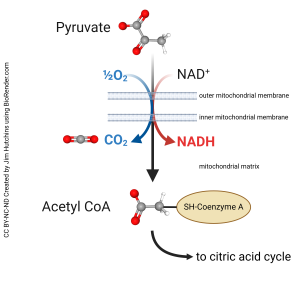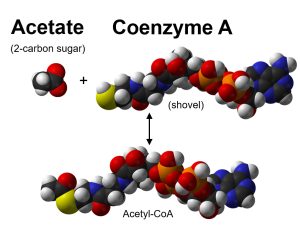Acetyl Coenzyme A Formation
Objective 5.6
5.6.1 State the critical features in the formation of acetyl-coenzyme A (acetyl-CoA).
Step 2 – Acetyl Coenzyme A Formation

As just covered, if enough oxygen is present, we can move on to the next step in cellular respiration—acetyl coenzyme A formation. We pick up where glycolysis ended, with two 3-carbon pyruvic acid molecules. The only way to get these into the citric acid cycle is via the coenzyme A shovel. But the coenzyme A shovel only holds a single 2-carbon molecule, so we must first remove one carbon from each pyruvic acid. The removed carbon is combined with an O2 molecule to form CO2 and the remaining 2-carbon acetyl group binds to coenzyme A (CoA), resulting in acetyl coenzyme A (acetyl-CoA).
 Now that you’ve been introduced to the coenzyme A molecule (p. 5-9), take a closer look at the business end. There, you’ll find a sulfhydryl (–SH) group. For that reason, we sometimes write the “empty shovel” of coenzyme A as CoA–SH.
Now that you’ve been introduced to the coenzyme A molecule (p. 5-9), take a closer look at the business end. There, you’ll find a sulfhydryl (–SH) group. For that reason, we sometimes write the “empty shovel” of coenzyme A as CoA–SH.
A group of enzymes forms a macromolecular machine called the pyruvate dehydrogenase complex. These enzymes transfer an acetyl (CH3 COO–) group to CoA, forming a –S– (disulfide) linkage. By-products of this reaction are CO2, NADH, and a proton (H+). The H carried by NADH and the proton can be used in the electron transport chain of the mitochondrion (step 4, Objective 8).
Media Attributions
- U05-018 formation of acetyl-CoA © Hutchins, Jim is licensed under a CC BY-NC-ND (Attribution NonCommercial NoDerivatives) license
- U05-012 Acetate Coenzyme A New © Benjah-bmm27 is licensed under a Public Domain license

